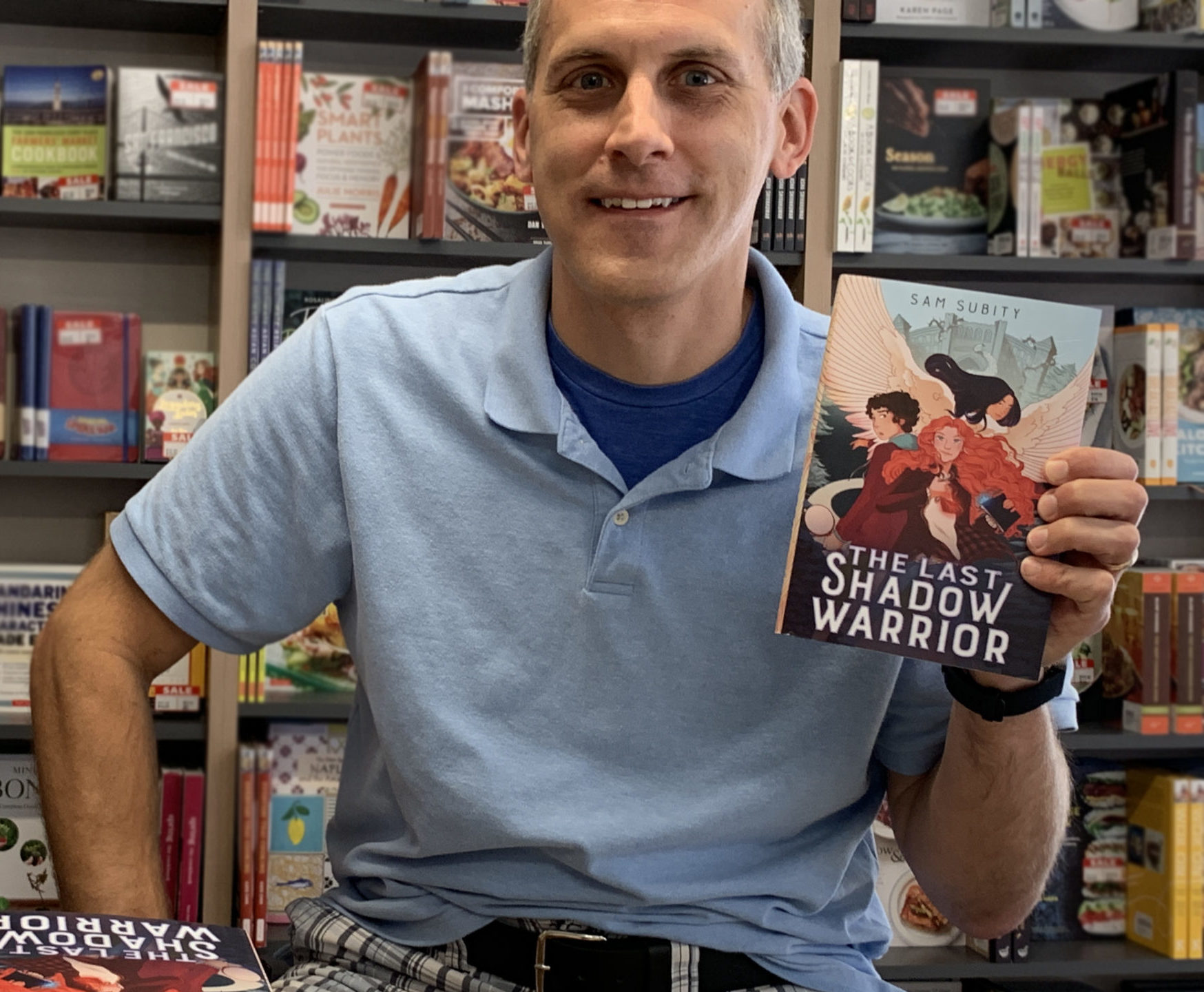Sam Subity and I are local writers together and members of a middle grade book club where authors meet monthly to discuss a particular middle grade novel with a focus on the craft of storytelling. It’s been a joy to watch Sam’s journey to publication. If you haven’t read his debut novel The Last Shadow Warrior yet, I highly recommend that you run to your nearest indie bookstore (or find one online.) I loved the adventure, humor and high-stakes in Sam’s tale about middle schooler (and modern day Viking warrior) Abby Beckett, deeply inspired by Nordic mythology. In our interview below, Sam chats about how he crafts a scene, starting with a vivid picture in his mind and also how he blends the familiar with the unfamiliar to deliver contemporary fantasy that a reader can easily relate to. We’re so delighted to spotlight Sam this month! Enjoy – Kristi

KidLit Craft: What inspired you to write THE LAST SHADOW WARRIOR?
Ever since my college days, I’ve been a big fan of Beowulf and the lore behind it, particularly since one of my favorite authors, J.R.R. Tolkien, drew on much the same well of inspiration for his stories of Middle-earth. When I came across Rick Riordan’s The Lightning Thief about a decade ago, my brain immediately started spinning with the idea of breathing new life into an ancient story like Beowulf the same way Riordan did with the Greek myths. And that’s when my twelve-year-old Viking named Abby Beckett was born.
KLC: Can you tell us a bit about your writing process? Pantser, plotter, or plantser? Character first or plot first?
Each of my stories seems to start with an idea or scene that I can picture vividly in my mind. So I’ll sit down to write initially without worrying about plot, or story structure, or even punctuation. Sometimes those scenes then sit in a folder on my computer for months or years until I figure out where the story goes from there. Probably a lot of writers have orphan scenes like that! But occasionally more of the story starts to unfold while I’m writing, and I start to create a loose outline that may be as simple as chapter titles that describe what happens in that chapter, such as “Fight with Sea Monster.” Those titles become the signposts on my journey to the story’s climax. And maybe that initial scene becomes the first chapter, or a middle chapter, but either way it’s the sort of initial seed around which I grow the rest of the story.
KLC: Now that you’ve written a mythological, magical adventure, do you have any tips for fellow writers in the middle of worldbuilding?
In my own writing, I have tried to apply the “Keep it Simple” principle to avoid filling my stories with so much new stuff that the reader becomes lost in the unfamiliar. One of the major ways that writing contemporary fantasy helps with this is that you already have the reader grounded in familiar surroundings. For example, the private school Vale Hall from my book which is set in suburban Minneapolis, onto which are layered fantastical elements like a sea monster in the school’s swimming pool. It doesn’t take such a stretch of the imagination (or word count) for the reader to follow along when you blend the familiar with the unfamiliar in this way.
KLC: You’re planning a trilogy…How did you leave room for books 2 and 3 in your debut novel?
One of the pieces of advice my editor had for me was not to hold back great ideas for the second or third books, meaning that I should put my best into the first book because if no one buys the first book, then there won’t be a second or third one. Practical and humbling advice, for sure! So I essentially wrote the first book as if it would be a stand alone with only some loose threads at the end to potentially weave into a second novel.
KLC: How has craft study informed your writing?
One of the first craft books I read was Stephen King’s On Writing. I figured, if anyone could speak with any authority on how to write well, it was him. And I took away a few key fundamentals from his book that I still use today. One is that I write my first drafts with the door closed — that is, I write for myself without any outside feedback. I think this is a corollary of Anne Lamott’s advice to write lousy first drafts because in either case you’re letting the creative process play out without worrying if the story is any good yet. King also says to write every day. As a parent, that…doesn’t always work for me. But I think the core of that advice is to establish a regular writing habit so that writing becomes a priority and not an afterthought. And finally, King says to read a lot, which advice I happily take as a license to sneak away when I can and dive into a good book!
KLC: What do you wish you had known about the publishing industry that you know now?
It’s probably no surprise, but the pandemic has left publishers more conservative than just a couple of years ago. That means many things, among them smaller advances, less willingness to commit to a series, and fewer marketing dollars for new, unproven authors. Above we already talked about how I had envisioned my current book as the first in a trilogy, but with the pandemic that’s not a sure thing as we wait for sales numbers to roll in. There have been some wonderful middle grade books released over the last year that struggled to find an audience amidst all the upheaval. And many authors have as a result had to apply their creative energies toward marketing and promotion at the expense of their writing time.
KLC: What one piece of advice would you like to give to aspiring middle-grade authors?
Don’t compare yourself to other writers. I know, it’s SO hard to avoid. One author sends ten queries and gets positive responses almost immediately while another emails dozens of agents with no response. One author sells the very first book she writes while another has seven manuscripts in a drawer and is working on his eighth. Here’s my point: Everyone’s journey is different. There’s more than one way to achieve your writing dreams. Comparing your writing journey to that of others will only make you crazy. As an author whose debut novel didn’t come until my 40s, I was starting to think I’d maybe missed the boat and wouldn’t ever be published. But now I’m looking forward to building my writing career as a sort of “second act” in my life story.
KLC: What do you feel you’ve gained from being a part of the KidLitCraft community?
As much as I wish I could have the major writing craft books memorized and readily available for mental retrieval at the moment I need them, the sheer number of books I read every year makes this about as likely as me remembering all the names (and birthdays!) of my daughter’s vast stuffed animal collection. So the way KidLitCraft applies key points from craft books to kids’ novels serves as amazing mini refresher courses in how working authors use these methods in their own writing. I particularly liked Anne-Marie Strohman’s study of points of view in The Penderwicks, and Jen Jobart’s look at what makes a compelling character in Ghost.
KLC: What’s next on the horizon for your new fans?
I’m hoping to get the chance to continue the story of my fierce Viking warrior in book 2 in that series, and in the meantime am developing a potential chapter book series as well. The truth is that when you publish your first book, you quickly understand that it’s really only the first tiny step to building a publishing career and the road ahead remains long. But I’m 100% here for the challenges and joys of continuing to pursue that dream.
I’m playing with several different ideas and formats so stay tuned!

Sam Subity loves writing stories that explore the magic and wonder of being a kid and is thrilled to share his writing with readers everywhere—both the young in age and the young at heart.
When he’s not writing, you might find him running the trails of northern California where the endless, winding miles past fog and ocean inspire stories of adventure and mystery.
Or he might be mowing his lawn. Because that’s what adults sometimes have to do.
But in either case, Sam Subity is very likely imagining himself fighting mythical creatures or at the prow of a dragon ship feeling the wind and sea spray on his face alongside his own Viking queen and their two Vikelets. His greatest hope is that in reading his books, you too may be transported to another place where, for a little while, you can exchange the ordinary for the extraordinary.
To find out more about Sam Subity and his novel, The Last Shadow Warrior, find him on his website or on Twitter @sjsubity.
If you enjoyed hearing about Sam Subity’s KidLit journey, check out these author Q&As too!
Kristi Wright (co-editor) writes picture books and middle grade novels. Her goal as a writer is to give children a sense of wonder, a hopefulness about humanity, and a belief in their future. She is represented by Kurestin Armada at Root Literary. She is an active volunteer for SCBWI and a 12 X 12 member. Find her at www.kristiwrightauthor.com and on Twitter @KristiWrite.


COMMENTs:
0